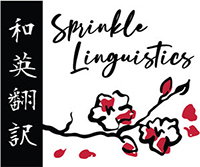
Scattered across the internet on social media and even translation company’s blogs are lists like “the most beautiful untranslateable” words, filled with words like 生きがい (Ikigai) “reason to live” or しょうがない (Shou ga nai) “It can’t be helped.” or 森林浴 (Shinrinyoku) literally “forest bath” meaning “a relaxing trip to the forest”. Obviously these terms can be translated and these very lists often do provide a gloss for these phrases, sometimes purposely choosing the least succinct and most clunky phrasing of the word or idiom.
These lists make me wonder, what do they mean by “untranselateable”? Could it be alluding to the fact that this concept doesn’t exist literally in English, influenced by the Sapir-Whorf theory that our thoughts are dictated by the language we speak? Alternatively, could it be referring to the fact that there is no single word equivalent for these terms?
Equivalence is, after all, the goal of translation, by rendering the subject text into a target text with the same meaning. Since Cicero, translation has been seen as a dichotomy between a word-for-word or literal translation versus a sense-for-sense or free translation. Yet this dichotomy shows the European bias of Translation Studies, focusing on often minor differences in comparing similar languages such as German and French. The very concept of a literal translation is laughable for vastly different languages such as English and Japanese, and taken to its extreme the resulting target language sentence would be utterly incomprehensible.
In the Meiji Era, there were some literary translators who took this foreignizing approach by translating every single pronoun and punctuation as it was in the Russian and French original, leading to a very awkward sounding translation in a language which rarely uses pronouns. Through these translations the term 彼 became associated with “he” rather than “that” and the term 彼の女 for “she” was calqued. (This term was simplified to 彼女 over time.) Interestingly enough, many common words in modern Japan such as 自由 and 社会 were calqued as literal translations during this period.
While equivalence is important in translations, it’s more complicated than simply replacing the source lexicon with a target equivalent. Mona Baker’s textbook In Other Words lists six different types of equivalence: word level, above word level (i.e., collocation, idioms, and expressions), grammatical, thematic and information structure of a text, textual cohesion, and pragmatism. While each word is important, it is the sum of the whole that determines the quality of a sentence and appropriateness of a translation.
After all, just because a term is difficult to translate or doesn’t have a single word translation does not mean it is untranslateable. These words may be stumbling blocks for the poor translator, but there are different methods to deal with such phrases, depending on the context and type of document it occurs in. A term can be translated literally, replaced with a more general term, it can be explained rather than translated, substituted for something more understandable to the audience, or in some cases, omitted.
These phrases and words that express something culturally significant (not necessarily unique) are what makes languages fascinating and allow you a window into a different way of thinking. However, language, like culture, is a living thing which continues to change over time, taking in new ideas and new phrases, calquing, borrowing, and coining new phrases and new ways of expressing ideas, yet also imbuing it with a new meaning over time. These lists are fun and insightful into new terms, yet they are hardly untranslateable.

